

Kathleen Goligher (born 1898) was an Irish spiritualist medium. Goligher was endorsed by engineer William Jackson Crawford who wrote three books about her. She was exposed as a fraud by physicist Edmund Edward Fournier d'Albe in 1921.


Kathleen Goligher (born 1898) was an Irish spiritualist medium. Goligher was endorsed by engineer William Jackson Crawford who wrote three books about her. She was exposed as a fraud by physicist Edmund Edward Fournier d'Albe in 1921.
Goligher was born in Belfast. She held séances in her own home with seven of her family members. The psychical researcher and engineer William Jackson Crawford (1881–1920) investigated the mediumship of Goligher and claimed she had levitated the table and produced ectoplasm. [1]
Crawford in his books developed the "Cantilever Theory of Levitation" due to his experiments with Goligher. According to his theory the table was levitated by "psychic rods" of ectoplasm which came out of the body of the medium to operate as an invisible cantilever. Crawford took flashlight photographs of the substance, which he described as "plasma". Crawford investigated Goligher's mediumship at her house for six years before his death. [2] Crawford's photographs of Goligher showed that the ectoplasm frequently issued from her vagina. [3]
There were no scientific controls in the Crawford's séances with Goligher. She and her family members had their hands and legs free at all times. [4] After Crawford's death the physicist Edmund Edward Fournier d'Albe investigated the medium Goligher at twenty sittings and arrived at the opposite conclusion to Crawford. According to d'Albe no ectoplasm or levitation had occurred with Goligher, and he stated he had found evidence of fraud. On 22 July 1921 he observed Goligher holding the table with her foot. [5] He also discovered that the "ectoplasm" substance in the photographs of Crawford was muslin. During a séance d'Albe had observed white muslin between Goligher's feet. [6]
In a letter to Harry Houdini, d'Albe wrote "I must say I was greatly surprised at Crawford's blindness." [7] The conclusion from d'Albe was that the Goligher family were involved in the mediumship trickery and had duped Crawford. D'Albe published The Goligher Circle in 1922 which exposed the fraudulent mediumship of Goligher. Because of the exposure, she retired from mediumship in the same year. [8]
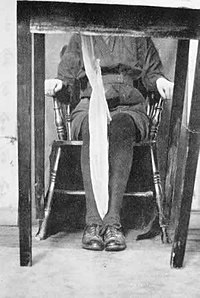
Crawford's experiments were criticized by scientists for their inadequate controls and lack of precaution against fraud. [9] [10]
Physician Morton Prince in the Journal of Abnormal Psychology noted that Crawford's psychic rod hypothesis "fails to account for much and cannot be reconciled with what is scientifically known as matter, or force, or electricity, or energy." [9]
A review in the Journal of Applied Psychology suggested that Crawford does "not seem to have been able to avoid self-deception, and his experiments are not convincing." [11]
Psychical researcher Hereward Carrington noted that the photographs taken by Crawford look "dubious in appearance" and that "with rare exceptions, no other investigators had an opportunity to check-up his results, since outsiders were rarely admitted to the sittings." [12]
The surgeon Charles Marsh Beadnell published a booklet in 1920 that debunked the experiments. He also offered a cash prize to any medium who could produce a single levitation under controlled conditions. [7]
Physician Bryan Donkin studied the Crawford experiments and called attention to "the superabundant exposure of the massive credulity and total defect of logical power displayed by Dr. Crawford," who gives "the most pathetic picture of a willing victim of pernicious deception". [13]
Psychologist Joseph Jastrow criticized the Crawford experiments as unscientific and wrote that "the minute detail of apparatus and all the paraphernalia of an engineering experiment which fills the Crawford books must ever remain an amazing document in the story of the metapsychic. As proof of what prepossession can do to a trained mind the case is invaluable." [14]
Joseph McCabe suggested that Goligher had used her feet and toes to levitate the table and move objects in the séance room and compared her fraudulent mediumship to Eusapia Palladino, who performed similar tricks. [15] Edward Clodd also dismissed the experiments as fraudulent and noted that Goligher refused invitation to be examined by a group of magicians and scientists. [16]
Researchers such as Ruth Brandon and Mary Roach have heavily criticized Crawford's investigation, describing him as credulous and having a sexual interest in Goligher, such as an obsession with her underwear. [8] [17] Crawford held a deep fixation on underwear; for example, psychical researcher Theodore Besterman noted that before his suicide, Crawford "spent all his money (consequently leaving nothing) on a stack of woollen underwear for his family, sufficient to last for several years." [8]
Susan Blackmore claimed that Eric Dingwall, an eccentric researcher interested in paranormal phenomena, told her around 1980 that Crawford had confessed before his death that all the Goligher phenomena were fraudulent. [18]

Spiritualism is a social religious movement primarily popular in the nineteenth and early twentieth centuries according to which an individual's awareness persists after death and may be contacted by the living. The afterlife, or the "spirit world", is seen by spiritualists not as a static place, but as one in which spirits continue to evolve. These two beliefs—that contact with spirits is possible, and that spirits are more advanced than humans—lead spiritualists to the belief that spirits are capable of providing useful insight regarding moral and ethical issues, as well as about the nature of God. Some spiritualists speak of a concept which they refer to as "spirit guides"—specific spirits, often contacted, who are relied upon for spiritual guidance. Emanuel Swedenborg has some claim to be the father of spiritualism.

A séance or seance is an attempt to communicate with spirits. The word séance comes from the French word for "session", from the Old French seoir, "to sit". In French, the word's meaning is quite general: one may, for example, speak of "une séance de cinéma". In English, however, the word came to be used specifically for a meeting of people who are gathered to receive messages from ghosts or to listen to a spirit medium discourse with or relay messages from spirits. In modern English usage, participants need not be seated while engaged in a séance.

The National Laboratory of Psychical Research was established in 1926 by Harry Price, at 16 Queensberry Place, London. Its aim was "to investigate in a dispassionate manner and by purely scientific means every phase of psychic or alleged psychic phenomena". The honorary president was Lord Sands, K.C., LL.D., acting president was H. G. Bois, and the honorary director was Harry Price. In 1930 the Laboratory moved from Queensberry Square, where it had been a tenant of the London Spiritualist Alliance to 13 Roland Gardens. In 1938, its library was transferred on loan to the University of London.

In Spiritualism, paranormal literature and some religions, materialization is the creation or appearance of matter from unknown sources. The existence of materialization has not been confirmed by laboratory experiments. Numerous cases of fraudulent materialization demonstrations by mediums have been exposed.

Levitation or transvection, in the paranormal or religious context, is the claimed ability to raise a human body or other object into the air by mystical means.

Harry Price was a British psychic researcher and author, who gained public prominence for his investigations into psychical phenomena and exposing fraudulent spiritualist mediums. He is best known for his well-publicised investigation of the purportedly haunted Borley Rectory in Essex, England.

Mediumship is the pseudoscientific practice of mediating communication between familiar spirits or spirits of the dead and living human beings. Practitioners are known as "mediums" or "spirit mediums". There are different types of mediumship or spirit channelling, including séance tables, trance, and ouija. The practice is associated with Spiritualism and Spiritism. A similar New Age practice is known as channeling.

Eusapia Palladino was an Italian Spiritualist physical medium. She claimed extraordinary powers such as the ability to levitate tables, communicate with the dead through her spirit guide John King, and to produce other supernatural phenomena.
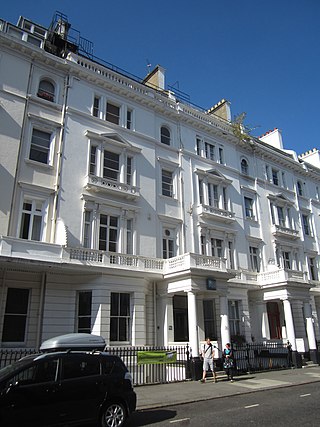
The College of Psychic Studies is a non-profit organisation based in South Kensington, London. It is dedicated to the study of psychic and spiritualist phenomena.

In spiritualism, ectoplasm, also known as simply ecto, a substance or spiritual energy "exteriorized" by physical mediums. It was coined in 1894 by psychical researcher Charles Richet. Although the term is widespread in popular culture, there is no scientific evidence that ectoplasm exists and many purported examples were exposed as hoaxes fashioned from cheesecloth, gauze or other natural substances.
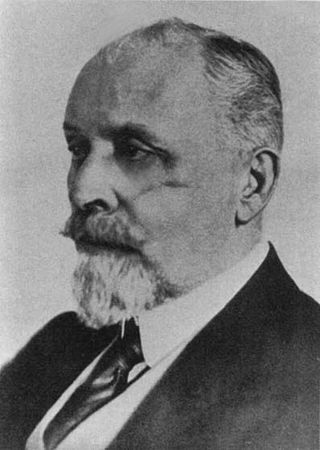
Albert Freiherr von Schrenck-Notzing was a German physician, psychiatrist and notable psychical researcher, who devoted his time to the study of paranormal events connected with mediumship, hypnotism and telepathy. He investigated Spiritualist mediums such as Willi Schneider, Rudi Schneider, and Valentine Dencausse. He is credited as the first forensic psychologist by Guinness World Records.
The American Society for Psychical Research (ASPR) is the oldest psychical research organization in the United States dedicated to parapsychology. It maintains offices and a library, in New York City, which are open to both members and the general public. The society has an open membership, anyone with an interest in psychical research is invited to join. It maintains a website; and publishes the quarterly Journal of the American Society for Psychical Research.

Eva Carrière, also known as Eva C, was a fraudulent materialization medium in the early 20th century known for making fake ectoplasm from chewed paper and cut-out faces from magazines and newspapers.

Franek Kluski, real name Teofil Modrzejewski (1873-1943), was a Polish physical medium criticized by trained magicians and skeptics as a fraud. Kluski was best known for his séances in which alleged "spirit" molds of hands materialized. It was later demonstrated by Massimo Polidoro and chemist Luigi Garlaschelli that these molds could have easily been made by fraudulent methods.

Walter Franklin Prince was an American parapsychologist and founder of the Boston Society for Psychical Research in Boston.

Hereward Carrington was an American investigator of psychic phenomena and author. His subjects included several of the most high-profile cases of apparent psychic ability of his times, and he wrote over 100 books on subjects including the paranormal and psychical research, conjuring and stage magic, and alternative medicine. Carrington promoted fruitarianism and held pseudoscientific views about dieting.
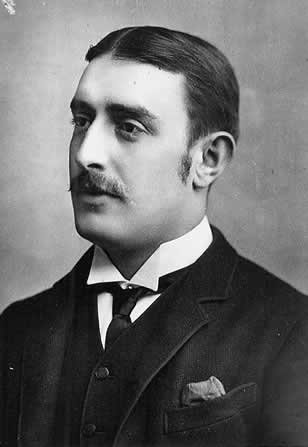
William Eglinton (1857–1933), also known as William Eglington was a British spiritualist medium who was exposed as a fraud.
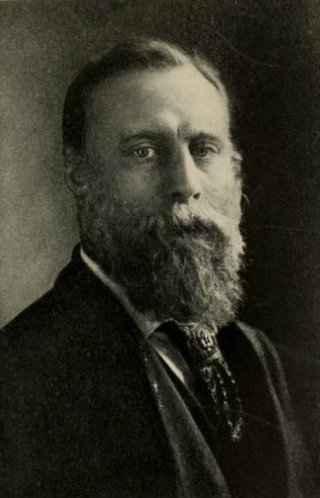
Richard Hodgson was an Australian-born psychical researcher who investigated spiritualist mediums such as Eusapia Palladino and Leonora Piper. During his later life, Hodgson became a spiritualist medium himself and believed to be in communication with spirits.

Stanisława Popielska most well known as Stanisława P. was a Polish spiritual medium who was alleged to have produced ectoplasm and the psychokinetic movement of objects.
William Wortley Baggally, most well known as W. W. Baggally, was a British psychical researcher who investigated spiritualist mediums.